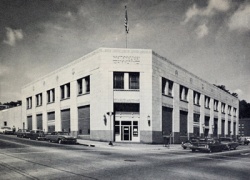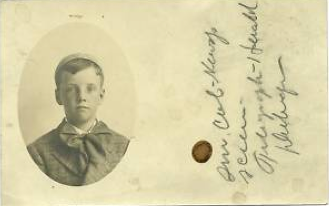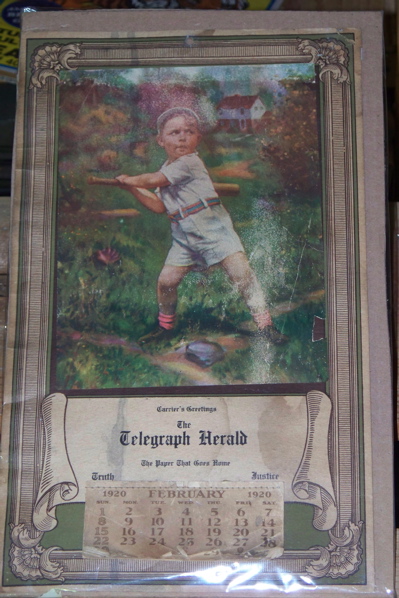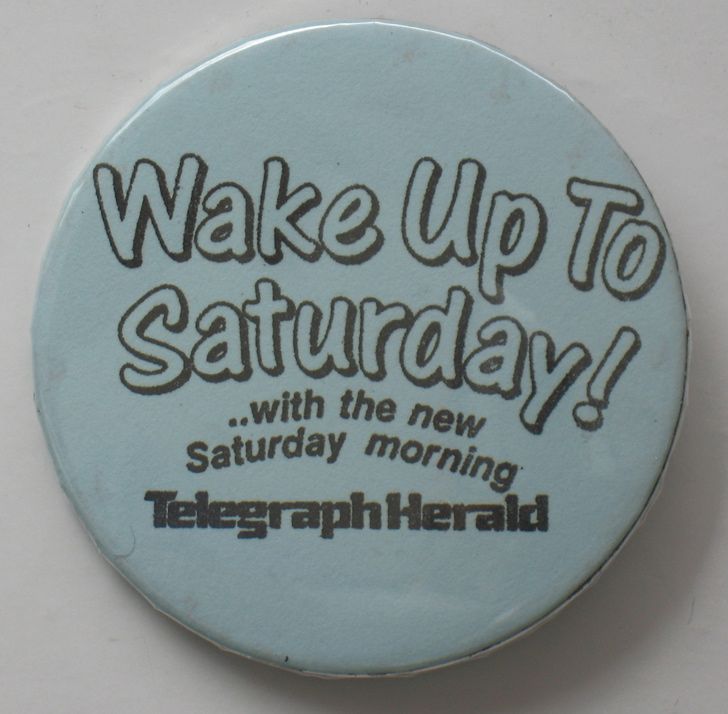Encyclopedia Dubuque
"Encyclopedia Dubuque is the online authority for all things Dubuque, written by the people who know the city best.”
Marshall Cohen—researcher and producer, CNN
Affiliated with the Local History Network of the State Historical Society of Iowa, and the Iowa Museum Association.
TELEGRAPH HERALD: Difference between revisions
No edit summary |
No edit summary |
||
| Line 8: | Line 8: | ||
The two newspapers merged on October 26, 1854. The new paper, known as The Daily Express and Herald, had nine columns and remained four pages. The word "Express" was dropped from the title on July 29, 1859 and the paper became ''The Dubuque Herald''. (4) | The two newspapers merged on October 26, 1854. The new paper, known as The Daily Express and Herald, had nine columns and remained four pages. The word "Express" was dropped from the title on July 29, 1859 and the paper became ''The Dubuque Herald''. (4) | ||
''The Dubuque Daily Telegraph'' was founded by [[MAHONY, Dennis|Dennis MAHONY]] on July 5, 1870. | ''The Dubuque Daily Telegraph'' was founded by [[MAHONY, Dennis|Dennis MAHONY]] on July 5, 1870. [[QUIGLEY, Patrick J.|Patrick J. QUIGLEY]] purchased the paper, but then sold it to the widow of Dennis Mahony and left the city. He returned to Dubuque and repurchased the paper on May 5, 1881. (5) When he purchased the paper, it had an assessed value of $3,500. Under his leadership, the paper in 1905 had a valuation of $20,000. (6) On October 27, 1891 the ''Dubuque Daily Telegraph'' was consolidated with ''The Dubuque Herald'' to become ''The Telegraph-Herald''. (5) | ||
The ''Telegraph'' had reached its 31st year of existence on July 6th, 1901. It had absorbed eight other newspapers during this time. (6) | The ''Telegraph'' had reached its 31st year of existence on July 6th, 1901. It had absorbed eight other newspapers during this time. (6) | ||
| Line 18: | Line 18: | ||
Industrial West---------------1889 | Industrial West---------------1889 | ||
In 1904 the Telegraph-Herald installed an Ostrander-Seymour press which guaranteed 18,000 copies of a four, six, eight, ten, twelve or sixteen page paper per hour. The machine failed to meet these requirements. It was replaced in 1905 by a press manufactured by R. Hoe & Company of New York. This machine had the capacity of 24,000 twenty-four page papers printed in four colors an hour and represented an investment of $25,000. (7) | In 1904 the Telegraph-Herald installed an Ostrander-Seymour press which guaranteed 18,000 copies of a four, six, eight, ten, twelve or sixteen page paper per hour. The machine failed to meet these requirements. It was replaced in 1905 by a press manufactured by R. Hoe & Company of New York. This machine had the capacity of 24,000 twenty-four page papers printed in four colors an hour and represented an investment of $25,000. (7) This acquisition was but the latest example of the newspapers commitment to staying on the forefront of the technology at the time. By that year, the paper would also claim: (8) | ||
the first patent mailer | |||
the first paper folder | |||
the first and only double cylinder press | |||
the first car load of print paper | |||
the first flat stereotyping outfit | |||
the first curved stereotyping outfit | |||
the first pneumatic tube system in Iowa | |||
the first web perfecting press, capacity 8,000 per hour | |||
the first two car loads of roll paper in one consignment | |||
the first electric clock, motor and lighting | |||
the first carrier boys' uniforms | |||
the first color disc | |||
the first Cottrell book press | |||
the first and only car of book paper received in Dubuque | |||
the largest car of roll print | |||
The Telegraph Herald was one of the city's major employers by 1905. The running expenses of the business in 1885 was $240 per week. In 1905 for the same length of time, the expenses had reached $2,700 with the greatest part paid to the 130 employees of the paper and the job printing department. (9) | |||
Quick to adopt modern ideas and machinery, the paper was called one of Iowa's finest. With circulation growing, the paper moved from rented space at 7th and Main into spacious quarters at 5th and Main. Quigley maintained an active role in the management of the paper until his death on February 23, 1917. His successor was [[WOODWARD, Fred W.|Fred W. WOODWARD]]. | Quick to adopt modern ideas and machinery, the paper was called one of Iowa's finest. With circulation growing, the paper moved from rented space at 7th and Main into spacious quarters at 5th and Main. Quigley maintained an active role in the management of the paper until his death on February 23, 1917. His successor was [[WOODWARD, Fred W.|Fred W. WOODWARD]]. | ||
| Line 31: | Line 50: | ||
Today the ''Telegraph Herald'' is a division of [[WOODWARD COMMUNICATIONS, INC.]] | Today the ''Telegraph Herald'' is a division of [[WOODWARD COMMUNICATIONS, INC.]] | ||
[[Image:TelegraphHerald.jpg|left|thumb|150px|Image courtesy: Mike Day. Kendall C. Day family collection]] | [[Image:TelegraphHerald.jpg|left|thumb|150px|Image courtesy: Mike Day. Kendall C. Day family collection]] | ||
In the same article, the newspaper recounted its publishing firsts: (7) | In the same article, the newspaper recounted its publishing firsts: (7) | ||
| Line 79: | Line 80: | ||
4. Ibid. | 4. Ibid. | ||
5. | 5. "The Greater Telegraph-Herald: The Story of Its Founding and Growth," ''Telegraph-Herald'', May 18, 1904 | ||
6. Ibid. | 6. Ibid. | ||
6. ''Telegraph-Herald First Paper..." | |||
7. "The Telegraph-Herald's Records of Achievement," ''Telegraph-Herald'', March 19, 1905, p. 17 | 7. "The Telegraph-Herald's Records of Achievement," ''Telegraph-Herald'', March 19, 1905, p. 17 | ||
8. Ibid. | |||
9. Ibid. | |||
Revision as of 20:57, 5 December 2014
This entry is being edited.
TELEGRAPH HERALD. In 1919 the National Historical Society meeting in Cincinnati, Ohio officially declared that the DUBUQUE VISITOR was the first newspaper west of the MISSISSIPPI RIVER. (1) The Telegraph Herald is the direct descendant of that paper. The "Visitor" was a weekly and the first copy consisted of four pages. On June 3, 1837 a new owner changed the name of the paper to the IOWA NEWS. On August 1, 1841 the paper was renamed MINER'S EXPRESS (THE). The paper was still four pages long in its original size of 16x21 inches. (2)
The Dubuque Tri-Weekly Herald was first available to the public on April 19, 1851. The four page paper was 14X21. Faced with competition, The Miner's Express announced a daily newspaper on August 19, 1851. This challenge was answered by the Dubuque Tri-Weekly Herald with its own daily. The two newspapers survived with an editor who also often served as a reporter and printer. Type was hand-set and the printing done on a hand-press. (3)
The two newspapers merged on October 26, 1854. The new paper, known as The Daily Express and Herald, had nine columns and remained four pages. The word "Express" was dropped from the title on July 29, 1859 and the paper became The Dubuque Herald. (4)
The Dubuque Daily Telegraph was founded by Dennis MAHONY on July 5, 1870. Patrick J. QUIGLEY purchased the paper, but then sold it to the widow of Dennis Mahony and left the city. He returned to Dubuque and repurchased the paper on May 5, 1881. (5) When he purchased the paper, it had an assessed value of $3,500. Under his leadership, the paper in 1905 had a valuation of $20,000. (6) On October 27, 1891 the Dubuque Daily Telegraph was consolidated with The Dubuque Herald to become The Telegraph-Herald. (5)
The Telegraph had reached its 31st year of existence on July 6th, 1901. It had absorbed eight other newspapers during this time. (6)
Daily and Weekly Dispatch-----1884
Daily and Weekly Democrat-----1885
Daily and Weekly Independent--1887
Industrial Leader-------------1888
Industrial West---------------1889
In 1904 the Telegraph-Herald installed an Ostrander-Seymour press which guaranteed 18,000 copies of a four, six, eight, ten, twelve or sixteen page paper per hour. The machine failed to meet these requirements. It was replaced in 1905 by a press manufactured by R. Hoe & Company of New York. This machine had the capacity of 24,000 twenty-four page papers printed in four colors an hour and represented an investment of $25,000. (7) This acquisition was but the latest example of the newspapers commitment to staying on the forefront of the technology at the time. By that year, the paper would also claim: (8)
the first patent mailer
the first paper folder
the first and only double cylinder press
the first car load of print paper
the first flat stereotyping outfit
the first curved stereotyping outfit
the first pneumatic tube system in Iowa
the first web perfecting press, capacity 8,000 per hour
the first two car loads of roll paper in one consignment
the first electric clock, motor and lighting
the first carrier boys' uniforms
the first color disc
the first Cottrell book press
the first and only car of book paper received in Dubuque
the largest car of roll print
The Telegraph Herald was one of the city's major employers by 1905. The running expenses of the business in 1885 was $240 per week. In 1905 for the same length of time, the expenses had reached $2,700 with the greatest part paid to the 130 employees of the paper and the job printing department. (9)
Quick to adopt modern ideas and machinery, the paper was called one of Iowa's finest. With circulation growing, the paper moved from rented space at 7th and Main into spacious quarters at 5th and Main. Quigley maintained an active role in the management of the paper until his death on February 23, 1917. His successor was Fred W. WOODWARD.
Woodward became president and general manager of the Telegraph-Herald in 1917. In 1927, he negotiated the merger of the paper with the Times Journal. The first issue of the paper printed in its present location at 8th and Bluff appeared on newsstands on July 14, 1930.
In 1965 the Woodward family purchased total control of the paper from the Quigley family. In 1966 newspaper publishing history was made when on February 29th the Telegraph Herald became the first to use the Goss Metro Offset double-wide press ever built.
Today the Telegraph Herald is a division of WOODWARD COMMUNICATIONS, INC.
In the same article, the newspaper recounted its publishing firsts: (7)
the first published list of farmers in Iowa
the first and only original and special premiums
to subscribers--a county directory
the first double-decked press to print 18,000
16-page papers per hour, folder in one part
the first three-deck, four-color perfecting press,
printing 24,000 24-page papers an hour and
the modern stereotyping plant going with it
the first to issue a state directory--the largest
book ever published west of the [[MISSISSIPPI
RIVER]] and the only directory ever published
containing a resume of the state, counties,
cities and towns and names of businesses and
professional men and farmers.
---
Source:
1. "Telegraph-Herald First Paper West of Mississippi, Decision of National Historical Society, Telegraph-Herald, November 30, 1919, p. 1
2. Ibid.
3. Ibid.
4. Ibid.
5. "The Greater Telegraph-Herald: The Story of Its Founding and Growth," Telegraph-Herald, May 18, 1904
6. Ibid.
6. Telegraph-Herald First Paper..."
7. "The Telegraph-Herald's Records of Achievement," Telegraph-Herald, March 19, 1905, p. 17
8. Ibid.
9. Ibid.





